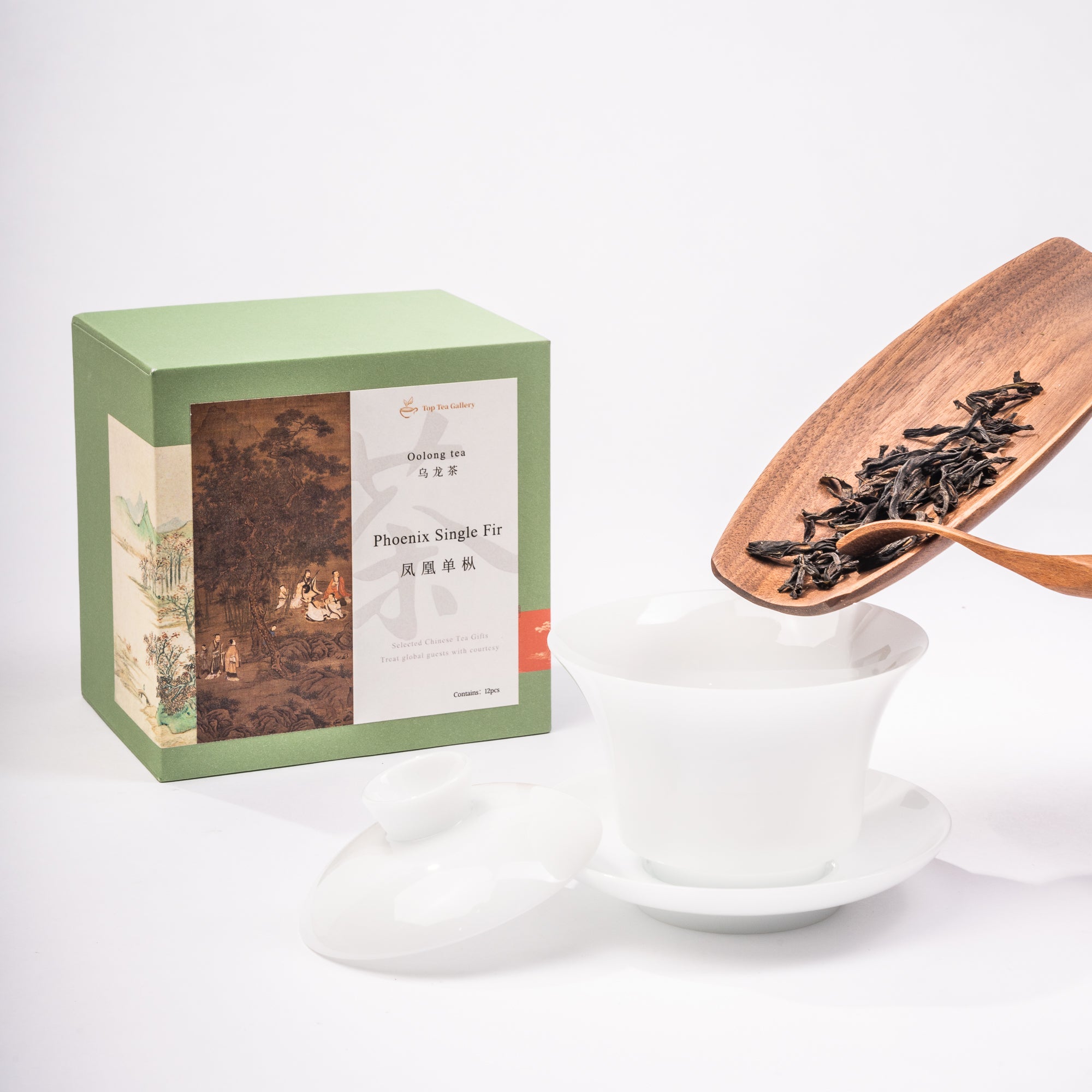







Phoenix single fir Oolong tea (凤凰单枞乌龙茶)
50 grams per box
About Oolong Tea(乌龙茶)
Its name, "Oolong," translates to "Black Dragon," a fitting moniker for a tea that boasts a rich history and a taste as majestic as its namesake.
What sets Chinese Oolong tea apart is its unique production process, which involves withering, oxidation, and rolling of the tea leaves—a delicate dance that results in a spectrum of flavors and aromas. Depending on the level of oxidation, Oolong teas can range from light and floral to dark and roasted, offering a diverse array of tasting experiences to suit every palate.
One of the most intriguing aspects of Chinese Oolong tea is its wide variety of cultivars and growing regions, each imparting its own distinct characteristics to the final brew. From the high mountain peaks of Fujian to the misty hillsides of Guangdong, every cup of Oolong tells a story of terroir and craftsmanship.
About Phoenix single fir(凤凰单枞乌龙茶)
This tea box contains 12pcs with 4-6grams per pc, total 50 grams.
This tea hails from the lush mountains of the Phoenix Mountain in Guangdong province, China, where it is meticulously handcrafted by skilled artisans. Renowned for its exceptional quality and unique flavor profile, Phoenix Single Fir Oolong has earned a stellar reputation among tea connoisseurs worldwide.
Characteristics of the Tea
Appearance
- Shape: The tea leaves are long, twisted, and slightly curled.
- Color: The dry leaves are dark green to brown with a glossy appearance.
Aroma
- Fragrance: Phoenix Dan Cong is known for its strong and captivating aroma, which can vary widely among different cultivars. Common scents include floral notes like orchid and osmanthus, fruity notes like peach and lychee, and honey undertones.
Flavor Profile
- Taste: The tea offers a complex, layered flavor with a perfect balance of floral, fruity, and honey notes. Each infusion reveals new depths of flavor, ranging from sweet and mellow to slightly astringent with a lingering sweetness.
- Aftertaste: Leaves a long-lasting, sweet, and floral aftertaste, often referred to as "hui gan."
Production Techniques
- Harvesting: The leaves are harvested from ancient tea trees in the Phoenix Mountain region, typically in the spring and early summer.
- Withering: The fresh leaves are spread out to wither and lose some of their moisture content, enhancing their aroma.
- Shaking: The leaves are gently shaken to bruise the edges, initiating oxidation and enhancing the tea's complex flavor.
- Oxidation: The leaves undergo partial oxidation, placing Phoenix Dan Cong between green and black tea in terms of flavor and color.
- Fixation: The leaves are pan-fried or baked to halt oxidation and preserve their unique qualities.
- Rolling: The leaves are rolled to shape them and further develop their flavor.
- Drying: The leaves are carefully dried to stabilize their flavor and ensure longevity.
Exceptional Qualities
- Varietal Diversity: Phoenix Dan Cong is unique in its varietal diversity, with each cultivar offering distinct aroma and flavor profiles.
- Ancient Tea Trees: Many of the tea trees used for Phoenix Dan Cong production are centuries old, contributing to the tea's depth and complexity.
- Artisanal Craftsmanship: The traditional production methods involve skilled craftsmanship, ensuring the highest quality and preservation of the tea's unique characteristics.
Health Benefits
- Antioxidants: Rich in antioxidants, which help combat free radicals and promote overall health.
- Mental Alertness: Contains moderate caffeine, which can improve mental alertness and focus.
- Digestive Aid: Known to aid digestion and soothe the stomach.
- Cardiovascular Health: Regular consumption is believed to support heart health and reduce cholesterol levels.
More Oolong Tea Brewing Tips:
-
Choose Quality Leaves: Start with high-quality Chinese Oolong tea leaves, preferably loose-leaf for optimal flavor. Look for tightly rolled leaves with vibrant color and aroma.
-
Water Temperature: Oolong tea is delicate, so finding the right water temperature is crucial. For lighter Oolongs, such as green or floral varieties, use water around 175-185°F (80-85°C). For darker, roasted Oolongs, aim for slightly higher temperatures, around 190-200°F (87-93°C).
-
Tea-to-Water Ratio: Use approximately 1 teaspoon of tea leaves per 8 ounces (240ml) of water. Adjust according to your taste preferences and the strength of the tea.
-
Steeping Time: The steeping time for Oolong tea can vary depending on the type and personal preference. Generally, steep lighter Oolongs for 2-3 minutes and darker Oolongs for 3-5 minutes. Experiment with different steeping times to find your perfect balance of flavor and strength.
-
Steeping Method: Use a teapot, gaiwan, or infuser to steep your Oolong tea. Avoid steeping directly in a cup, as it can result in uneven extraction and bitterness.
-
Multiple Infusions: One of the delights of Oolong tea is its ability to be steeped multiple times. After the initial steeping, enjoy subsequent infusions, gradually increasing the steeping time with each infusion to extract new layers of flavor.
-
Savor the Aroma: Before taking your first sip, take a moment to appreciate the aroma of the brewed tea. Inhale deeply and let the fragrance transport you to the tea's place of origin.
-
Enjoy Mindfully: Finally, sip your brewed Oolong tea slowly and mindfully, allowing the flavors to unfold on your palate. Notice the nuances of taste and aroma with each sip, and savor the moment of tranquility that tea brings.
-
Don't forget to select a teapot and tea pet to spend the best tea time with you!
Choose options








High Quality small package Tea to create a light leisure tea life
Need help?
Frequently Asked Questions
Referencing our "Make the Perfect Cup of Tea" instructions, take 1 Tou Cha (remove the paper wrapping), place it into a pre-heated teapot or cup, add 16 oz boiling water, and steep 5 + minutes. Respectfully, drink plain.
Pu-Erh tea is most commonly formed into bricks or cakes and traditionally used as a form of currency.
Pu-Erh is a black tea and is therefore high in caffeine, compared to green or oolong tea.
You may also like
Community Favorites


















